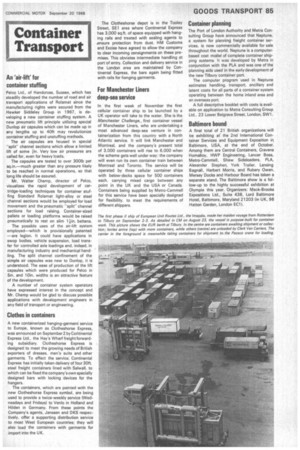Container Transport
Page 89

If you've noticed an error in this article please click here to report it so we can fix it.
An 'air-lift' for container stuffing
Pelco Ltd„ of Handcross, Sussex, which has steadily developed the number of road and air transport applications of Rolamat since the manufacturing rights were secured from the Hawker Siddeley Group in 1967, is developing a new container stuffing system. A new pneumatic lift principle utilizing special Dunlop air capsules which can be made up in any lengths up to 40ft may revolutionize container stuffing and unstuffing methods.
The air capsules are housed in special "split" channel sections which allow a limited lift of some in, Very low air pressures are called for, even for heavy loads.
The capsules are tested to over 3001b per sq.in.—much greater than any pressure likely to be reached in normal operations, so that long life should be assured.
Mr. Walter Champ, director of Pe!co, visualizes the rapid development of cartridge-loading techniques for container stuffing Standard Rolamat light-alloy or steel channel sections would be employed for load movement and the pneumatic "split" channel sections for load raising. Container-sized pallets or loading platforms would be raised pneumatically to rest on slim 1iin, battens.
The possible uses of the air-lift system employed—which is provisionally patented —are legion. It could have applications in swop bodies, vehicle suspension, load transfer for controlled axle loadings and, indeed, in manufacturing industry and mechanical handling. The split channel confinement of the simple air capsules was new to Dunlop, it is understood. The ease of production of the lift capsules which were produced for Peleo in 51n. and 10in, widths is an attractive feature of the development.
A number of container system operators have expressed interest in the concept and Mr. Champ would be glad to discuss possible applications with development engineers in any field of transport or engineering.
Clothes in containers
A new containerized hanging-garment service to Europe, known as Clotheshorse Express, was announced on September 2 by Continental Express Ltd„ the Hay's Wharf freight forwarding subsidiary. Clotheshorse Express is designed to meet the growing needs of British exporters of dresses, men's suits and other garments. To effect the service, Continental Express has initially taken delivery of four 30ft. steel freight containers lined with Salwall, to which can be fixed the company's own specially designed bars with locking devices for the hangers.
The containers, which are painted with the new Clotheshorse Express symbol, are being used to provide a twice-weekly service (Wednesdays and Fridays) to Vertlo in Holland and Hilden in Germany. From these points the Company's agents, Janssen and DKS respectively, offer a supporting distribution service to most West European countries: they will also load the containers with garments for import into the UK, The Clotheshorse depot is in the Tooley Street, SE1 area where Continental Express has 3,000 sq.ft. of space equipped with hanging rails and treated with sealing agents to .ensure protection from dust. HM Customs and Excise have agreed to allow the company to clear incoming consignments on these premises. This obviates intermediate handling at port of entry. Collection and delivery service in the London area are maintained by Continental Express, the bars again being fitted with rails for hanging garments.
For Manchester Liners deep-sea service
In the first week of November the first cellular container ship to be launched by a UK operator will take to the water. She is the Manchester Challenge, first container vessel of Manchester Liners, who are undertaking a most advanced deep-sea venture in containerization from this country with a North Atlantic service. It will link Manchester and Montreal, and the company's present total of 3,000 containers will rise to 6.000 when the scheme gets well under way: the company will even run its own container train between Montreal and Toronto, The service will be operated by three cellular container ships with below-decks space for 500 containers each, carrying mixed cargo between any point in the UK and the USA or Canada. Containers being supplied by Metro-Cammell for this service have been specially designed for flexibility, to meet the requirements of different shippers.
Container planning
The Port of London Authority and Metre Consulting Group have announced that Neptune, a system for planning freight container services, is now commercially available for sale throughout the world. Neptune is a computerbased cost model of complete container shipping systems. it was developed by Metra in conjunction with the PLA and was one of the planning aids used in the early development of the new Tilbury container port.
The computer program used in Neptune estimates handling. transport, ancillary arid latent costs for all parts of a container system operating between the home inland area and an overseas port.
A full descriptive booklet with costs is available on application to Metre Consulting Group Ltd., 23 Lower Belgrave Street. London, SW1.
Baltimore hound A final total of 21 British organizations will be exhibiting at the 2nd International Container Services and Equipment Exposition in Baltimore, USA, at the end of October. Among them are Central Containers, Cravens Homalloy, HWP Engineering, Lancer Boss, Metro-Cammell, Shaw Sideioaders, PLA, Alexander Stephen, York Trailer, Lansing Bagnall, Herbert Morris, and Rubery Owen. Mersey Docks and Harbour Board has taken a separate stand. The Baltimore show is a follow-up to the highly successful exhibition at Olympia this year. Organizers: Mack-Brooks Expositions Ltd., Suite 438, Lord Baltimore Hotel, Baltimore, Maryland 21203 in UK, 96 Hatton Garden, London Ed).


















































































































































































































































































































































































